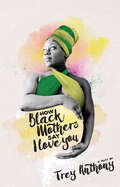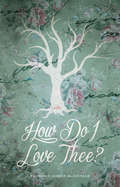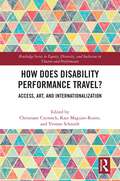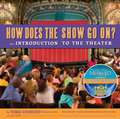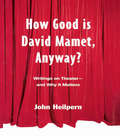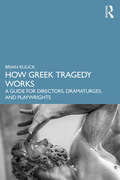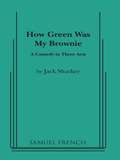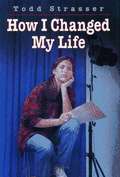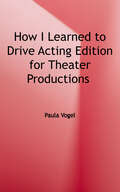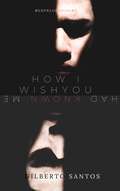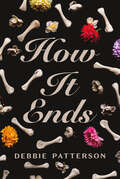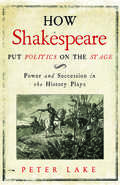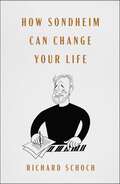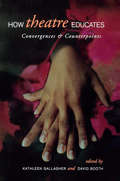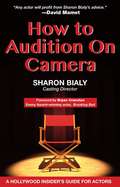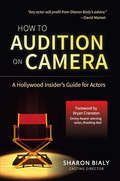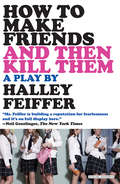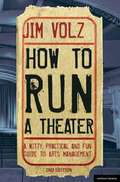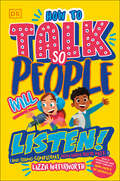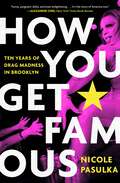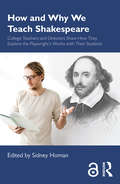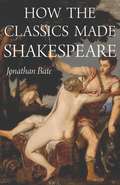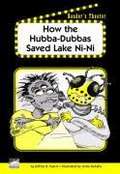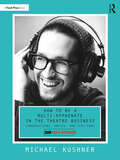- Table View
- List View
How Black Mothers Say I Love You
by Trey AnthonyClaudette still can’t forgive her mother for leaving. For six years of her childhood, Claudette and her sister Valerie were left with their grandmother while their mother, Daphne, moved from Jamaica to the United States to start a new chapter for their family. But in that time, Daphne remarried and had another daughter. Claudette, now in her late thirties, travels to visit her dying mother in Brooklyn, but that doesn’t stop her anger and abandonment issues from bubbling up. It doesn’t stop Daphne from voicing her opinions on how Claudette lives her life, either. With Daphne, Claudette, and Valerie all under one roof again, each family member is forced to confront their emotions while there’s still time. Though rooted in buried strife and sadness, How Black Mothers Say I Love You is full of humour, love and tenderness as it explores the complicated perceptions of immigrant mothers.
How Do I Love Thee?
by Florence Gibson MacdonaldVictorian poets Elizabeth Barrett Browning and Robert Browning are as renowned for their passionate relationship as they are their poetry. How Do I Love Thee? revisits the life of the 19th-century poets from their courtship, carried out entirely through letters, to their sudden elopement to their tumultuous marriage marred by drug addiction and financial strife.
How Does Disability Performance Travel?: Access, Art, and Internationalization (Routledge Series in Equity, Diversity, and Inclusion in Theatre and Performance)
by Yvonne Schmidt Christiane Czymoch Kate Maguire-RosierThis edited collection investigates the myriad ways in which disability performance travels in a globalized world. Disability arts festivals are growing in different parts of the world; theatre and dance companies with disabled artists are increasingly touring and collaborating with international partners. At the same time, theatre spaces are often not accessible, and the necessity of mobility excludes some disabled artists from being part of an international disability arts community. How does disability performance travel, who does not travel – and why? What is the role of funding and producing structures, disability arts festivals and networks around the world? How do the logics of international (co-)producing govern the way in which disability art is represented internationally? Who is excluded from being part of a touring theatre or dance company, and how can festivals, conferences, and other agents of a growing disability culture create other forms of participation, which are not limited to physical co-presence? This study will contextualize disability aesthetics, arts, media, and culture in a global frame, yet firmly rooted in its smaller national, state, and local community settings and will be of great interest to students and scholars in the field.
How Does The Show Go On?: An Introduction To The Theater (A Disney Theatrical Souvenir Book)
by Jeff Kurtti Thomas SchumacherFilled with detailed explanations, captivating illustrations, and entertaining trivia, this clearly written, lively, and uniquely-designed book is a first-of-its-kind introduction to the world of the Theatre, from the box office to backstage, and beyond. From one side of the book, the reader enters via the front door, where the people and activities of the “front of house” can be examined. From the book’s other side, the reader enters the “Stage Door,” where the behind-the-scenes world of the “Back of house” is revealed. In exploring this visually-inviting “theatre of the mind,” readers encounter the people, places, occupations, and equipment of the theatre world, and have the opportunity to investigate them all. From the box office and the Usher Staff to the Dressing Rooms and the Backstage doorman, the reader may wander at will within this one-of-a-kind world, discovering the wonders of theatre all along the way.
How Good is David Mamet, Anyway?: Writings on Theater--and Why It Matters
by John HeilpernFirst Published in 2000. Routledge is an imprint of Taylor & Francis, an informa company.
How Greek Tragedy Works: A Guide for Directors, Dramaturges, and Playwrights
by Brian KulickHow Greek Tragedy Works is a journey through the hidden meanings and dual nature of Greek tragedy, drawing on its foremost dramatists to bring about a deeper understanding of how and why to engage with these enduring plays. Brian Kulick dispels the trepidation that many readers feel with regard to classical texts by equipping them with ways in which they can unpack the hidden meanings of these plays. He focuses on three of the key texts of Greek theatre: Aeschylus' Agamemnon, Euripides' The Bacchae, and Sophocles' Electra, and uses them to tease out the core principles of the theatre-making and storytelling impulses. By encouraging us to read between the lines like this, he also enables us to read these and other Greek tragedies as artists' manifestos, equipping us not only to understand tragedy itself, but also to interpret what the great playwrights had to say about the nature of plays and drama. This is an indispensable guide for anyone who finds themselves confronted with tackling the Greek classics, whether as a reader, scholar, student, or director.
How Green Was My Brownie
by Jack SharkeyComedy / 6m, 5f / Interior / A bit of madness is loose in the Flinder house. Winifred Flinder, supposedly just out of the hospital, insists she was living it up in Paris. Her husband thinks she is planning to go into the convent, while their daughter Bonnie suspects both of her parents are nuts. The nurse thinks the neighboring piano teacher is a great pediatric surgeon and the gynecologist gratefully accepts payment for an operation he may not have performed. Add to this a general handyman who insists the brownies have it in for the Flinders, a housekeeper who expects to be murdered in her bed, a neighbor whose purse contains anything from crowbars to teddy bears and an unsolicited appearance by the Headless Horseman and you have this jolly jaunt through a superstition ridden environs where anything can happen and eventually does.
How I Changed My Life
by Todd StrasserA knee injury has left football star Kyle Winthrop sitting on the sidelines of high school life. Bolita Vine has vowed to change her image. She loses weight and works on becoming more assertive. She even lands the job of stage managing the school play. When Kyle tries out for the play, he and Bo become friends. But when Bo tries to take the relationship one step further, she soon learns the difference between fantasy and reality.
How I Learned to Drive
by Paula VogelTHE STORY: A wildly funny, surprising and devastating tale of survival as seen through the lens of a troubling relationship between a young girl and an older man. How I Learned to Drive is the story of a woman who learns the rules of the road and l
How I wish you had known me (DRAMA / Gay & Lesbian #1)
by Gilberto SantosIs it possible to fall in love with someone who's already gone? Lucas and Lauro never met, not in this life... But what would only be an uncompromising holiday trip in the interior of São Paulo turns around the life of Lauro, a psychologist always willing to help. His beliefs are to put to the test amid events that defy logic. After being involved in a mysterious suicide that would hit the small town of Vinhedo, his help to the dead's family would not end as expected; soon Lauro would be involved and in love with Lucas. On the other side, unknowingly, it would also be helping his soul mate to rise spiritually. Follow and be moved by this story, which leaves no doubt that death is just a journey and that soul mates really exist
How It Ends
by Debbie PattersonMost of us, when faced with death, wish we could just have a little more time. But what if this is the little more time that we wished for? What are you going to do with it? Grieving siblings Natalie and Bart have differing views on how we die. Natalie, a palliative care nurse, knows how drugs can help ease someone’s pain, and do so on their own terms; Bart, a minister, believes that surrendering to what may come can bring peace and wisdom. Through this immersive show about end-of-life choices, Natalie and Bart are guided by a disabled angel who helps them address their mother’s final decision and understand their own hopes and fears about death. Packed with relatable existential questions, this joyously engaging and reflective play offers a welcoming space to think about what comes next.
How Shakespeare Put Politics on the Stage: Power and Succession in the History Plays
by Peter LakeA masterful, highly engaging analysis of how Shakespeare's plays intersected with the politics and culture of Elizabethan England With an ageing, childless monarch, lingering divisions due to the Reformation, and the threat of foreign enemies, Shakespeare's England was fraught with unparalleled anxiety and complicated problems. In this monumental work, Peter Lake reveals, more than any previous critic, the extent to which Shakespeare's plays speak to the depth and sophistication of Elizabethan political culture and the Elizabethan imagination. Lake reveals the complex ways in which Shakespeare's major plays engaged with the events of his day, particularly regarding the uncertain royal succession, theological and doctrinal debates, and virtue and virt#65533; in politics. Through his plays, Lake demonstrates, Shakespeare was boldly in conversation with his audience about a range of contemporary issues. This remarkable literary and historical analysis pulls the curtain back on what Shakespeare was really telling his audience and what his plays tell us today about the times in which they were written.
How Sondheim Can Change Your Life
by Richard SchochDiscover the powerful and universal lessons from the music and lyrics of Stephen Sondheim, the genius behind such musical theater masterworks as Company, West Side Story, and Into the Woods.Stephen Sondheim died on November 26, 2021, but for countless fans around the world, he is &“still here,&” to quote one of his lyrics. With acclaimed revivals of his landmark shows occurring around the world and introducing new generations to the man who transformed American musical theater, Sondheim&’s legacy has only grown. What is it about such classic songs as &“Rose&’s Turn&” from Gypsy, &“Send in the Clowns&” from A Little Night Music, and &“Children Will Listen&” from Into the Woods that speaks to us so intimately and profoundly? How Sondheim Can Change Your Life makes the case that Sondheim&’s greatness—beyond the clever lyrics and adventurous music—rests in his ability to tell stories that relate to us all. From Louise&’s desire for freedom as Gypsy Rose Lee to Sweeney Todd&’s thirst for revenge, we as an audience relate easily to Sondheim&’s characters. His works understand us as much as we understand them. Following the arc of Sondheim&’s career, How Sondheim Can Change Your Life is rich with stories about productions and iconic performers, deep readings of his music and lyrics, and insights into his creative process. But more than that, it reveals how Sondheim&’s works can enrich our own lives.
How Theatre Educates
by Kathleen Gallagher David BoothCanada boasts a remarkable number of talented theatre artists, scholars, and educators. How Theatre Educates brings together essays and other contributions from members of these diverse communities to advocate for a broader and more inclusive understanding of theatre as an educative force.Organized to reflect the variety of contexts in which professionals are making, researching, and teaching drama, this anthology presents a wide range of articles, essays, reminiscences, songs, poems, plays, and interviews to elucidate the relationship between theatre practice and pedagogy, and to highlight the overriding theme: namely, that keeping 'education' - with its curriculum components of dramatic literature and theatre studies in formal school settings - separate from 'theatre' outside of the classroom, greatly diminishes both enterprises.In this volume, award-winning playwrights, directors, actors, and scholars reflect on the many ways in which those working in theatre studios, school classrooms, and on stages throughout the country are engaged in teaching and learning processes that are particular to the arts and especially genres of theatre. Situating theatre practitioners as actors in a larger socio-cultural enterprise, How Theatre Educates is a fascinating and lively inquiry into pedagogy and practice that will be relevant to teachers and students of drama, educators, artists working in theatre, and the theatre-going public.ContributorsMaja ArdalDavid BoothPatricia CanoDiane FlacksKathleen GallagherJohn GilbertSky GilbertJim GilesLinda GriffithsTomson HighwayJanice HladkiCornelia HooglandAnn-Marie MacDonaldLori McDougallJohn MurrellDomenico PietropaoloWalter PitmanRichard RoseJason ShermanLynn SlotkinLarry SwartzJudith ThompsonGuillermo VerdecchiaBelarie Zatzman
How To Audition On Camera: A Hollywood Insider's Guide for Actors
by Sharon Bialy Bryan CranstonTo win a role in a movie or on network or cable TV, you must make a strong first impression in your brief, crucial audition--and the first person you have to impress is the casting director. In How to Audition On Camera, Casting Director Sharon Bialy answers the twenty-five questions actors ask most frequently about how to nail an audition. What is the casting director looking for? If you mess up, can you start over? What is the most common mistake experienced actors make? Should you audition off book or can you look at the page? Should you dress in character? How much can you improvise? Actors--both novice and professional--are often misled by myths and outdated prescriptions. This guide replaces such misinformation with concise and accurate advice from someone who is in the room helping to make the decision on who gets the job. Bialy gets readers started immediately on the road to screen acting success.
How To Audition On Camera: A Hollywood Insider's Guide for Actors
by Sharon Bialy Bryan CranstonFirst Time in Print Updated and expanded To win a role in a movie or on network or cable TV, you must make a strong first impression in your brief, crucial audition—and the first person you have to impress is the casting director. In How to Audition On Camera, Casting Director Sharon Bialy answers the twenty-five questions actors ask most frequently about how to nail an audition. What is the casting director looking for? If you mess up, can you start over? What is the most common mistake experienced actors make? Should you audition off book or can you look at the page? Should you dress in character? How much can you improvise? Actors—both novice and professional—are often misled by myths and outdated prescriptions. This guide replaces such misinformation with concise and accurate advice from someone who is in the room helping to make the decision on who gets the job. Bialy gets readers started immediately on the road to screen acting success.
How To Make Friends and Then Kill Them: A Play
by Halley FeifferThe uproarious and borderline repulsive play about two neglected sisters and their oddball friend by the author of I’m Gonna Pray For You So Hard. Left to their own devices by their alcoholic mother, Ada and Sam cultivate an insular world into which they soon draw a third wheel – a pockmarked, limping wallflower named Dorrie. In the years spanning childhood to young adulthood, these three troubled girls learn to lean on each other completely, finding ways to fill each other up and to tear each other down. But when a horrible accident turns their reality upside down, they find they must decide whether they will continue to foster their familiar, codependent cycle, or whether they will break free, with or without each other’s aid.
How To Run A Theatre: A Witty, Practical And Fun Guide To Arts Management
by Jim VolzThe first edition of How to Run a Theatre sold out within months of initial publication and it took the cries of the field and pleadings of professors who use the book in their university classes to encourage me to search for a publisher for this second edition. <P><P>Fortunately, publisher Jenny Ridout with London's esteemed Methuen Drama/A & C Black Publishers Limited took time to review the book and take it to her Board. The results are before you - an updated edition with new sections, new contacts and new teaching tools.
How To Talk So People Will Listen: And Sound Confident (Even When You’re Not)
by Lizzie WaterworthFind your voice and own the room, even when your legs are shaking!Professional cartoon voice artist Lizzie Waterworth tells you all about her strategies for confident speaking, from breathing exercises to what to do with your hands, and how to conquer that pesky inner voice that whispers "what if...?".Packed with funny stories from Lizzie's world of cartoons, and top tips from a host of professional voice artists and public figures, such as Stephen Fry, David Menkin, and BBC presenter Ben Shires, this book is full of practical advice to help you find your voice!'We teach our children reading and writing but we forget listening and speaking, which are essential life skills. Lizzie brilliantly fills that gap for speaking in this fun, easy to read manual for children of all ages (and parents too!). Every child should have this!' - Julian Treasure, top-10 TED speaker and author of How To Be Heard'The book looks really brilliant - I will definitely be using it for homework sessions with my younger ones.' - Dr Natalie Cawley, counselling psychologist and psychotherapist'Lizzie has a terrific way of helping folks overcome natural fears about speaking in front of others, and this book very much captures her spirit and energy. In How to Talk so People Will Listen, she draws on her professional knowledge and experience to treat the topic seriously while also making it fun.' - James Tierney, Yale University English Language Programs'This book is perfect for helping young ones learn essential skills and grow self-confidence all whilst having fun reading!' - Claudia Dalley, Head of POP Channels'This book is great because it's instructional without being full of jargon...and it's funny too! Definitely one for children and adults even!' - Monique Berry, Headteacher'It&’s like a cartoon on the outside and inside the playfulness continues. I really think this book is an invaluable resource. Although this book is designed for young people, Lizzie&’s advice is applicable to people of any age.' - Ranny Levy, Founder and President, KIDS FIRST! / Coalition for Quality Children's Media
How You Get Famous: Ten Years of Drag Madness in Brooklyn
by Nicole PasulkaA madcap adventure through a tight-knit world of drag performers making art and mayhem in the greatest city on earth.Ten years ago, an aimless coat check girl better known today as Merrie Cherry sweet-talked her boss into giving her $100 to host a drag show at a Brooklyn dive bar. Soon, kids like Aja were kicking their way into the scene, sneaking into clubs, pocketing their tips to help mom pay the mortgage, and sharing the stage with electric performers like Thorgy Thor and Sasha Velour. Because suddenly, in the biggest, brightest city in America, drag was offering young, broke, creative queer people a chance at real money—and for thousands or even millions of people to learn their names. In How You Get Famous, journalist Nicole Pasulka joyfully documents the rebirth of the New York drag scene, following a group of iconoclastic performers with undeniable charisma, talent, and a hell of a lot to prove. The result is a sweeping portrait of the 21st-century search for celebrity and community, as well as a chronicle of all the struggles, fights, and disappointments along the way. A rollicking account of the quest to make a living through an art form on the cusp of becoming a cultural phenomenon, How You Get Famous offers an unmissable romp through the gritty and glamorous world of Brooklyn drag.
How and Why We Teach Shakespeare: College Teachers and Directors Share How They Explore the Playwright’s Works with Their Students
by Sidney HomanIn How and Why We Teach Shakespeare, 19 distinguished college teachers and directors draw from their personal experiences and share their methods and the reasons why they teach Shakespeare. The collection is divided into four sections: studying the text as a script for performance; exploring Shakespeare by performing; implementing specific techniques for getting into the plays; and working in different classrooms and settings. The contributors offer a rich variety of topics, including: working with cues in Shakespeare, such as line and mid-line endings that lead to questions of interpretation seeing Shakespeare’s stage directions and the Elizabethan playhouse itself as contributing to a play’s meaning using the "gamified" learning model or cue-cards to get into the text thinking of the classroom as a rehearsal playing the Friar to a student’s Juliet in a production of Romeo and Juliet teaching Shakespeare to inner-city students or in a country torn by political and social upheavals. For fellow instructors of Shakespeare, the contributors address their own philosophies of teaching, the relation between scholarship and performance, and—perhaps most of all—why in this age the study of Shakespeare is so important.
How the Classics Made Shakespeare (E. H. Gombrich Lecture Series #3)
by Jonathan BateFrom one of our most eminent and accessible literary critics, a groundbreaking account of how the Greek and Roman classics forged Shakespeare’s imaginationBen Jonson famously accused Shakespeare of having “small Latin and less Greek.” But he was exaggerating. Shakespeare was steeped in the classics. Shaped by his grammar school education in Roman literature, history, and rhetoric, he moved to London, a city that modeled itself on ancient Rome. He worked in a theatrical profession that had inherited the conventions and forms of classical drama, and he read deeply in Ovid, Virgil, and Seneca. In a book of extraordinary range, acclaimed literary critic and biographer Jonathan Bate, one of the world’s leading authorities on Shakespeare, offers groundbreaking insights into how, perhaps more than any other influence, the classics made Shakespeare the writer he became.Revealing in new depth the influence of Cicero and Horace on Shakespeare and finding new links between him and classical traditions, ranging from myths and magic to monuments and politics, Bate offers striking new readings of a wide array of the plays and poems. At the heart of the book is an argument that Shakespeare’s supreme valuation of the force of imagination was honed by the classical tradition and designed as a defense of poetry and theater in a hostile world of emergent Puritanism.Rounded off with a fascinating account of how Shakespeare became our modern classic and has ended up playing much the same role for us as the Greek and Roman classics did for him, How the Classics Made Shakespeare combines stylistic brilliance, accessibility, and scholarship, demonstrating why Jonathan Bate is one of our most eminent and readable literary critics.
How the Hubba-Dubbas Saved Lake Ni-Ni
by Jeffrey Fuerst Anne Flounders Anita DufallaPerform this script about two tribes that must learn to live and work together.
How to Be a Multi-Hyphenate in the Theatre Business: Conversations, Advice, and Tips from “Dear Multi-Hyphenate”
by Michael KushnerHow to Be a Multi-Hyphenate in the Theatre Business empowers theatre professionals to take hold of their own career and become successful ‘multi-hyphenates’– artists with multiple proficiencies, often cross-pollinating each other to help flourish professional capabilities. Discussing self-identity, networking, workflow, failure, passion, purpose, socially responsible artistry, social media, and the effects of COVID-19, Michael Kushner, award-winning theatre multi-hyphenate artist, sets the stage for artists of all disciplines and backgrounds to find personalized success in the theatre industry. Complete with informative and lively exercises and excerpts from Kushner’s popular podcast and workshop, Dear Multi-Hyphenate, this book addresses questions such as: How do we recover from a pandemic? How do we give more access to marginalized theatre creators? and What goes into producing our own projects? Featuring exclusive information from a myriad of theatre makers such as agents, managers, designers, actors, press representatives, producers, comedians, social media stars, writers, executive directors, CEOs, and lawyers, this book promotes the dismantling of gatekeeping and provides a specialized, hands-on experience to an innovative and lucrative approach to theatre making. How to Be a Multi-Hyphenate in the Theatre Business is an invaluable resource for theatre artists at any level in their careers, whether they are undergraduates, graduate students, professors, award-winning members of the theatre and film community, working professionals, high school students, or entrepreneurs.
